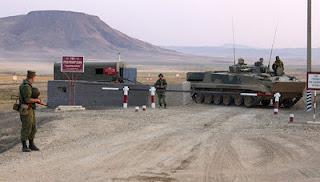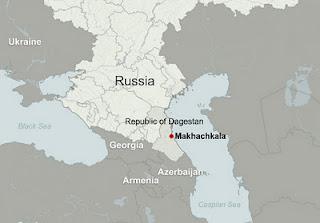 On Friday evening, Russian security forces clashed with separatist militias in the North Caucasus republic of Dagestan, leaving four service members and five militants killed, while several others were injured. According to the Itar-Tass news agency, the clash happened during a police operation in a forest between Chernyayevka and Ukrainsky in the district of Kizlyar. As explained by the National Counter Terrorism Committee spokesman Nikolai Sintsov, “the militants opened fire with a machine gun and sub-machine guns when the police tried to block them in a dugout.” Militants in the region continue to carry out attacks against security forces, police and civilians, more than a decade after the second Chechen war finished.
On Friday evening, Russian security forces clashed with separatist militias in the North Caucasus republic of Dagestan, leaving four service members and five militants killed, while several others were injured. According to the Itar-Tass news agency, the clash happened during a police operation in a forest between Chernyayevka and Ukrainsky in the district of Kizlyar. As explained by the National Counter Terrorism Committee spokesman Nikolai Sintsov, “the militants opened fire with a machine gun and sub-machine guns when the police tried to block them in a dugout.” Militants in the region continue to carry out attacks against security forces, police and civilians, more than a decade after the second Chechen war finished.
The importance of Russia’s southernmost republic for the stability of the federation has been recently stressed by Russian Prime Minister Vladimir Putin. “Dagestan is the largest republic of the Northern Caucasus and needs special attention,” said Putin on Monday at a discussion on ethnic issues in the North Caucasian spa town of Kislovodsk. “For centuries, the southern regions of our country have been inhabited by courageous, brave and strong-willed people. Each nationality possesses its own language, culture, unique traditions, wonderful interesting customs, but all of them have two things in common: the Motherland Russia and a centuries-old, very controversial, however, but a great history,” the Russian Prime Minister added, warning that if the peoples of the country are separated, “Russia will become helpless dependent and vulnerable.”
The geopolitical importance of Dagestan relies on both its geographical location and its ethnic composition. The largest among the North Caucasian republics, Dagestan is located on the Western coast of the Caspian Sea and hosts some of the facilities of the Caspian Flotilla, which has grown in importance after the collapse of the Soviet Union as a result of international tensions with Iran and the increasing role of Caspian oil and gas in the international trade of hydrocarbons. On the other hand, the republic is inhabited by several dozens of ethnic groups. According to the 2010 Census, Avars, Dargins, Tabasarans, Lezgins and other North Caucasian peoples make up almost 75% of the population of Dagestan, while the remaining part is made up of Turkic peoples, Kumyks, Nogais, Azeris and Russians, these last ones representing the 4% of the total population. GEOGRAPHICAL LOCATION OF DAGESTAN
 The only factor uniting these peoples is Islam. Dagestanis are largely Sunni Muslims, with a Shia minority (primarily made of the Azeris) on the Caspian coast. Nevertheless, the conflict in Dagestan is not between Sunni and Shia, but between Sufism and Salafism. Jamaat Shariat, officially the Islamic Jamaat of Dagestan “Shariat,” is the largest Islamist militant organization in the republic.
The only factor uniting these peoples is Islam. Dagestanis are largely Sunni Muslims, with a Shia minority (primarily made of the Azeris) on the Caspian coast. Nevertheless, the conflict in Dagestan is not between Sunni and Shia, but between Sufism and Salafism. Jamaat Shariat, officially the Islamic Jamaat of Dagestan “Shariat,” is the largest Islamist militant organization in the republic. The group, created during the Second Chechen War in favour of Dagestan’s independence as an Islamic state, is still closely associated with the separatist conflicts in Chechnya and Ingushetia, and is also known to have members and bases in Azerbaijan. Aimed at establishing a “fair society” based on sharia law, the Jamaat considers it legitimate to target police and security officials, and even some civilians such as the government-loyalist Muslim clergy and clerics of the Russian Orthodox Church, claiming to be prepared for a long-term guerrilla war of attrition that may be broadened to encompass the whole of the Russian Federation, including Moscow and St. Petersburg.
Beyond the claims of the group, an escalation of the conflict in Dagestan would actually produce effects on a national scale. The loss of Russian control over the territory as a consequence of a successful separatist war would in fact trigger a domino effect, awakening aspirations for independence not only in the North Caucasian republics of Chechnya, Ingushetia, Kabardino-Balkaria and North Ossetia-Alania, already the scene of clashes between armed gangs and security forces, but even in republics such Tatarstan and Bashkortostan, which relations with Moscow have been peaceful so far. It is therefore no exaggeration to say that Dagestan, with its three million people, is the most important test for a Russia that is always more determined to regain control over its “Near Abroad,” but whose own largeness is its first challenge, yesterday and today.

